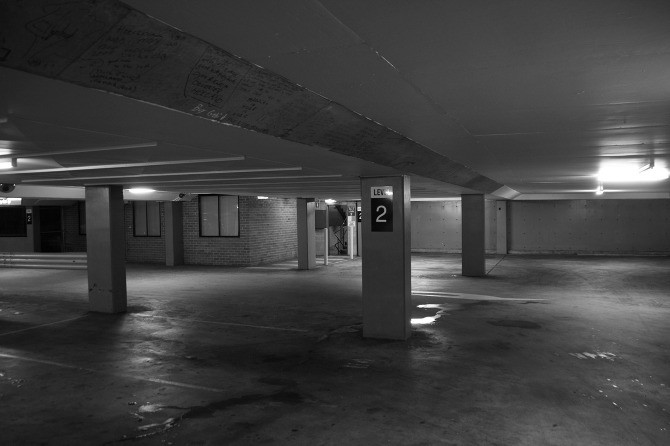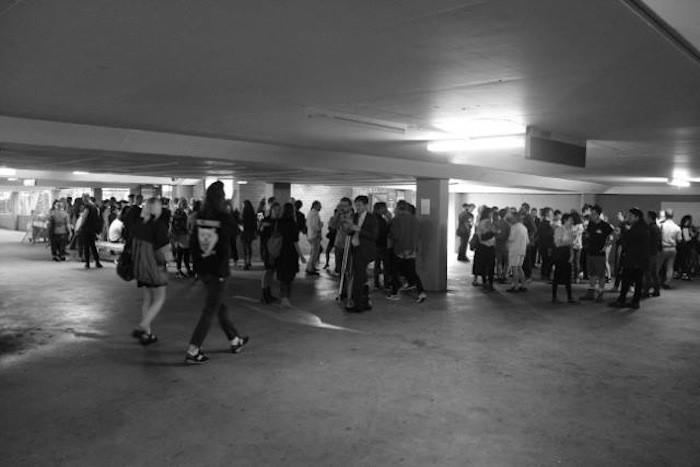
But she’s not afraid to die, the people all call her Alaska
Between worlds so the people ask her ‘cause it’s all in her mind
It's all in her mind
- Stephanie Says, The Velvet Underground
Just before Sebastian Goldspink opened Alaska Projects in October 2011, I ran into him in on the street of our (then) shared Kings Cross neighbourhood. He was busy building a new artist-run initiative “just over there” – he said, pointing at the car park across the road. Located in the bowels of this multi-level underground parking station was a disused mechanics office measuring a mere 25 square meters, the exact size of two parking spots. Sebastian’s eccentric vision was to transform it into a project space. Needless to say, I thought he was a little unhinged at the time.
Of the inspirations for his underground gallery project, Sebastian points to Stephanie Says, a 1968 song by The Velvet Underground in which the titular subject is dubbed ‘Alaska’ by her friends because she is beautiful but cold and distant. “I liked the idea that the space is in Kings Cross, the most densely populated area in the country,” he explains. “Yet when you’re at Alaska Projects at night it feels like you’re cold and alone, completely in the middle of nowhere.”
Alaska held 20 shows in its first year, most running for two or three weeks. Alaska drew upon a network of friends who formed a loose advisory committee who would consult, curate and exhibit. Much later Alaska outgrew the committee approach when in 2015, Bradley Vincent was appointed as Gallery Director and co-curated the gallery program with Sebastian until it closed in 2018. Together they opened a second two-room space on the ground level of the car park, which initially was a stockroom and then a gallery space with an office that also for a time hosted Big Ego, a bespoke vintage bookseller run by artists Raquel Caballero and Emily Hunt.
Over the years, Alaska held court with a cavalcade of artists working across media and at varying stages of practice. Alaska championed then-emerging artists including Sarah Contos, Samuel Hodge, Tarik Ahlip, Jason Phu, Angela Tiatia, Tina Havelock Stevens and Ramesh Mario Nithiyendran, while peppering the program with established artists like Tony Albert, Lauren Berkowitz, Mitch Cairns, Alex Gawronski, Agatha Gothe-Snape, Jess Johnson and Darren Sylvester.
Memorable moments at Alaska often engaged with or responded directly to the resonances and connotations yielded through the site itself – the car park. As part of Janis, a feminist group show curated by Kelly Doley in 2013, Hannah Furmage staged God Forgives, Outlaws Don’t. Furmage recruited a peloton of bikies for the performance to rev their motorcycles for what seemed like an eternity, an amusingly obnoxious spectacle choked by noxious fumes. A year earlier, The Motel Sisters (aka Liam Benson and Naomi Oliver) were curated by Joel Mu into Passing Parade. They exhibited a kitschy spray-painted car bonnet called Kingswood High with the Windows Down, and on opening night took punters hooning on a fast loop of the car park with music blaring, shouting and honking – “until security put an end to it lol,” they reminisced recently.
Without question, the best car culture contribution to Alaska was from Ms&Mr (who now practice as nova Milne). Their brooding site-specific installation Occult to do list 1988/2012 used JG Ballard’s iconic 1973 novel Crash as its stimulus. Fusing sex and smashup, the nod to Ballard was not only apt in this context, it also poked serious fun at Alaska’s neighbouring Sydney Travellers Car Market, where hungover backpackers loitered with their questionably roadworthy vehicles for sale, undoubtedly confused by the presence of art in the car park.
Acquired at the time by the Art Gallery of Western Australia, Ms&Mr’s work was one of many to enter public collections. Artbank, the federal government artist support program and leasing collection, acquired from Alaska on occasion with works by Serena Bonson, Catherine Clayton-Smith, Robin Hearfield, Philjames and Kate Scardifield entering its collection. My work True Colours was acquired by Wollongong Art Gallery and Murray Art Museum Albury following its solo presentation in 2016. And Nell’s Let There Be Robe which showed at Alaska in 2013 after being commissioned by Mona in 2012, became part of the Gold Coast’s HOTA collection years much later in 2017. When institutional collection curators sniff around artist-run initiatives it is a great testament to the quality of programming and buzz generated locally and beyond.
Indeed the notion of ‘the local’ was an important impetus for Alaska. Upon inception, Alaska’s vision appropriated the phrase: think globally, act locally. Sebastian says: “With Alaska I want to use the strength of where we come from – Kings Cross – but not isolating that to just Sydney. I want the audience to be wide, to be in a sense global.” This played out several times when Alaska went abroad and staged exhibitions in New Orleans (Good Children, 2012), Los Angeles (Werkärtz Gallery, 2014), Christchurch (Dog Park, 2014) and participated in the London Art Fair (2018) as part of the curated projects section in which nine international galleries were invited by curator Misal Adnan Yildiz to present stands solely representing female identified artists.
Alaska was always committed to diversity along the lines of gender and queer representation (though I will leave it to the CoUNTess to perform the final tally). Situated on Gadigal land, Alaska’s commitment to First Nations artists was always a strong priority with big-name artists like Tony Albert, Dean Cross, Amala Groom, Nicole Monks, Reko Rennie, Jason Wing and Steaphan Paton making solid appearances.
A member of the Gunai and Monero Nations, Paton’s 2016 solo show Come In was the Naarm/Melbourne based artist’s first show in Sydney. It was also notably one of the first exhibitions at Alaska Projects [William Street], which Sebastian opened as an extension of the car park program. Light-filled with high ceilings and a creepy basement, the shopfront in East Sydney’s busy William Street was a former car rental outlet, a perfect conceptual companion to the car park gallery in nearby Kings Cross. For William Street, the initial focus was on more commercially oriented exhibitions that gradually morphed into an artist studio complex that housed Elliott Bryce Foulkes, Biljana Jancic, James Kerr, Samuel Hodge, Tara Marynowsky, Nell, Philjames, Marian Tubbs, and myself.
Aside from the unexpected car park setting, what set Alaska apart was its audacity not just as a program but also for the social networks it enabled and nourished. The voluminous archive of black-and-white opening night social photos posted frequently to Facebook evidence a veritable who’s who of the Sydney scene from that time. It is the only gallery I have ever known where you were greeted with a whiskey on the rocks, a lingering scent of gasoline, and the work of a shit-hot artist whose name you didn’t know then but who now rules the world.

Unpublished essay on the history of Alaska Projects from January 2020.
Published by danmudcun.com in 2024.